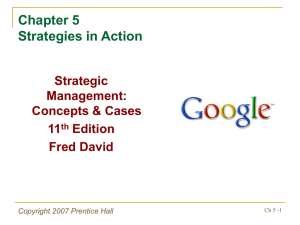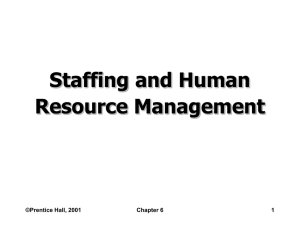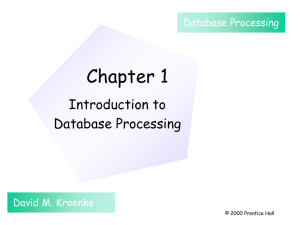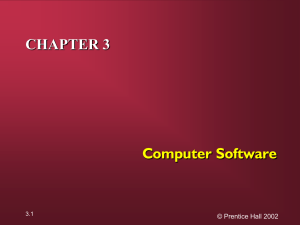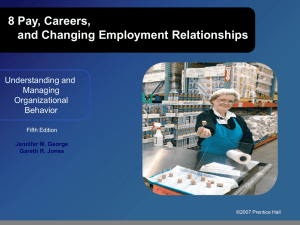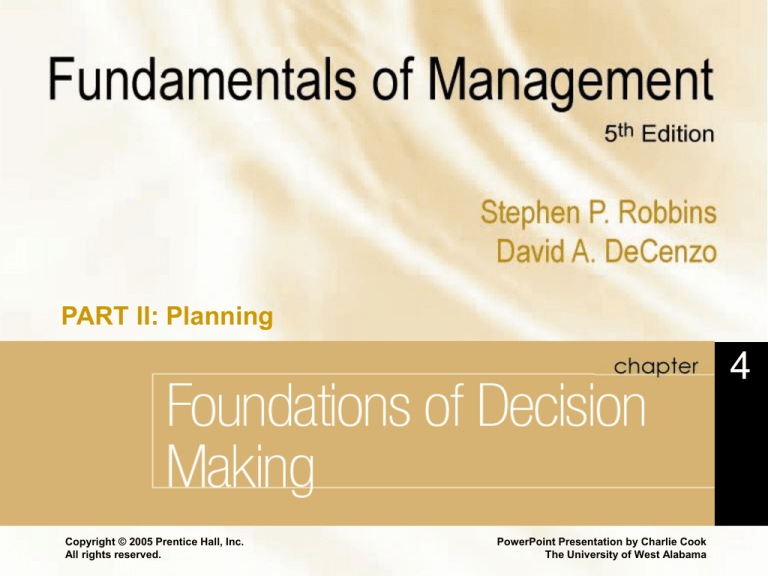
PART II: Planning
4
Chapter 4
Foundations of Decision Making
Copyright © 2005 Prentice Hall, Inc.
All rights reserved.
PowerPoint Presentation by Charlie Cook
The University of West Alabama
Learning Outcomes
After reading this chapter, I will be able to:
1. Describe the steps in the decision-making process.
2. Identify the assumptions of the rational decisionmaking model.
3. Explain the limits to rationality.
4. Define certainty, risk, and uncertainty as they relate
to decision making.
5. Describe the actions of the bounded-rational
decision maker.
Copyright © 2005 Prentice Hall, Inc. All rights reserved.
4–2
Learning Outcomes (cont’d)
After reading this chapter, I will be able to:
6. Identify the two types of decision problems and the
two types of decisions that are used to solve them.
7. Define heuristics and explain how they affect the
decision-making process.
8. Identify four decision-making styles.
9. Describe the advantages and disadvantages of
group decisions.
10. Explain three techniques for improving group
decision making.
Copyright © 2005 Prentice Hall, Inc. All rights reserved.
4–3
Decision-making
• Decision-making process
A set of eight steps that includes identifying a
problem, selecting a solution, and evaluating the
effectiveness of the solution
• Problem
A discrepancy between an existing and a desired
state of affairs
• Decision criteria
Factors that are relevant in a decision
Copyright © 2005 Prentice Hall, Inc. All rights reserved.
4–4
Examples of Planning-Function Decisions
What are the organization’s long-term objectives?
What strategies will best achieve those objectives?
What should the organization’s short-term objectives be?
What is the most efficient means of completing tasks?
What might the competition be considering?
What budgets are needed to complete department
tasks?
How difficult should individual goals be?
Exhibit 4.1
Copyright © 2005 Prentice Hall, Inc. All rights reserved.
4–5
The Decision-Making Process
Exhibit 4.2
Copyright © 2005 Prentice Hall, Inc. All rights reserved.
4–6
Criteria and Weight in Car-Buying Decision
(Scale of 1 to 10)
CRITERION
WEIGHT
Price
10
Interior comfort
8
Durability
5
Repair record
5
Performance
3
Handling
1
Exhibit 4.3
Copyright © 2005 Prentice Hall, Inc. All rights reserved.
4–7
Assessment of Car Alternatives
Exhibit 4.4
Copyright © 2005 Prentice Hall, Inc. All rights reserved.
4–8
Weighting of Vehicles
(Assessment Criteria X Criteria Weight)
Exhibit 4.5
Copyright © 2005 Prentice Hall, Inc. All rights reserved.
4–9
Decision-making (cont’d)
• Decision implementation
Putting a decision into action; includes conveying the
decision to the persons who will be affected by it and
getting their commitment to it.
Copyright © 2005 Prentice Hall, Inc. All rights reserved.
4–10
Making Decisions: The Rational Model
• Certainty
The implication that the outcome of every possible
alternative is known.
• Uncertainty
A condition under which there is not full knowledge of
the problem and reasonable probabilities for
alternative outcomes cannot be determined.
• Risk
The probability that a particular outcome will result
from a given decision.
Copyright © 2005 Prentice Hall, Inc. All rights reserved.
4–11
Assumptions of Rationality
Exhibit 4.6
Copyright © 2005 Prentice Hall, Inc. All rights reserved.
4–12
What Is Creative Potential?
• Expertise
Understanding, abilities, knowledge, proficiencies,
necessary in the field of creative endeavor.
• Creative-thinking skills
The personality characteristics associated with
creativity, the ability to use analogies, as well as the
talent to see the familiar in a different light.
• Intrinsic task motivation
The desire to work on something because it’s
interesting, involving, exciting, satisfying, or
personally challenging.
Copyright © 2005 Prentice Hall, Inc. All rights reserved.
4–13
Three Elements
of Creativity
Creativity
The ability to produce
novel and useful ideas
Source: T. M. Amabile. “Motivating Creativity in Organizations,” Califormia Management Review (Fall 1997), p. 43.
Copyright © 1997, by The Regents of the University of California. Reprinted by permission of the Regents.
Copyright © 2005 Prentice Hall, Inc. All rights reserved.
Exhibit 4.7
4–14
Making Decisions: The Rational Model
• Rational
Describes choices that are consistent and valuemaximizing within specified constraints.
• Bounded rationality (Herbert Simon)
Behavior that is rational within the parameters of a
simplified model that captures the essential features
of a problem.
• Satisfice
Making a “good enough” decision: choosing the firstidentified alternative that satisfactorily and sufficiently
solves the problem.
Copyright © 2005 Prentice Hall, Inc. All rights reserved.
4–15
Common Decision-making Errors
• Heuristics: Using judgmental shortcuts
Availability heuristic
The
tendency to base judgments on information that is
readily available.
Representative heuristic
The
tendency to base judgments of probability on things
(objects or events) that are familiar
Escalation of commitment
An
increased commitment to a previous decision
despite negative information about the decision’s
present outcomes.
Copyright © 2005 Prentice Hall, Inc. All rights reserved.
4–16
How Do Problems Differ?
• Well-structured problems
Straightforward, familiar, easily defined problems
• Ill-structured problems
New problems in which information is ambiguous or incomplete
• Programmed decision
A repetitive decision that can be handled by a routine approach
• Nonprogrammed decisions
Decisions that must be custom-made to solve unique and
nonrecurring problems
Copyright © 2005 Prentice Hall, Inc. All rights reserved.
4–17
Programmed Decision-Making Aids
• Policy
A general guide that establishes parameters for
making decisions about recurring problems.
• Procedure
A series of interrelated sequential steps that can be
used to respond to a well-structured problem (policy
implementation).
• Rule
An explicit statement that tells managers what they
ought or ought not to do (limits on procedural
actions).
Copyright © 2005 Prentice Hall, Inc. All rights reserved.
4–18
Types of Problems, Types of Decisions,
and Level in the Organization
Exhibit 4.8
Copyright © 2005 Prentice Hall, Inc. All rights reserved.
4–19
Technology And Decision Making
• Expert systems
Software that acts like an expert in analyzing and
solving ill-structured problems
Use
specialized knowledge about a particular problem
area rather than general knowledge
Use qualitative reasoning rather than numerical
calculations
Perform at a level of competence higher than that of
nonexpert humans.
• Neural networks
Software that is designed to imitate the structure of
brain cells and connections among them
Copyright © 2005 Prentice Hall, Inc. All rights reserved.
4–20
Decision Making: Styles
• Directive style
Characterizes the low tolerance for ambiguity and a
rational way of thinking of individuals who are logical
and efficient and typically make fast decisions that
focus on the short term.
• Analytic style
Characterizes the high tolerance for ambiguity
combined with a rational way of thinking of
individuals who prefer to have complete information
before making a decision.
Copyright © 2005 Prentice Hall, Inc. All rights reserved.
4–21
Decision Making: Styles (cont’d)
• Conceptual style
Individuals who tend to be very broad in outlook, to
look at many alternatives, and to focus on the long
run and often look for creative solutions.
• Behavioral style
Individuals who think intuitively but have a low
tolerance for uncertainty; they work well with others,
are open to suggestions, and are concerned about
the individuals who work for them.
Copyright © 2005 Prentice Hall, Inc. All rights reserved.
4–22
Decision-Making Styles
Exhibit 4.9
Copyright © 2005 Prentice Hall, Inc. All rights reserved.
4–23
Group Decision Making
• Advantages
Make more accurate
decisions
Provides more complete
information
Offers a greater diversity of
experiences and
perspectives
Generates more alternatives
Increases acceptance of a
solution
Increases the legitimacy of
a decision.
Copyright © 2005 Prentice Hall, Inc. All rights reserved.
• Disadvantages
Is more time-consuming
and less efficient
Minority domination can
influence decision process
Increased pressures to
conform to the group’s
mindset (groupthink)
Ambiguous responsibility for
the outcomes of decisions
4–24
When Are Groups Most Effective?
• Creativity
Groups tend to be more creative than individuals.
• Acceptance of the final solution
Groups help increase the acceptance of decisions.
• Effectiveness of group decision making
Groups of five to seven members are optimal for
decision process speed and quality.
Copyright © 2005 Prentice Hall, Inc. All rights reserved.
4–25
Improving Group Decision Making
• Brainstorming
An idea-generating process that encourages
alternatives while withholding criticism.
• Nominal group technique
A decision-making technique in which group members
are physically present but operate independently.
• Electronic meeting
A type of nominal group technique in which
participants are linked by computer.
Copyright © 2005 Prentice Hall, Inc. All rights reserved.
4–26
Web Links
• Visit the Robbins/DeCenzo companion Website
At www.prenhall.com/robbins for this chapter’s Internet
resources, including chapter quiz and student PowerPoints.
• Diversity Perspectives
Log onto www.prenhall.com/onekey and take the role of the
foundation director trying to turn a potentially “bad” committee
into a “good” one.
• Enhancing Your Skill in Ethical Decision Making
Log onto www.prenhall.com/onekey and get ready to enhance
your skill in ethical decision making.
Copyright © 2005 Prentice Hall, Inc. All rights reserved.
4–27
Video Case Application
The Management Picture: Quick Takes Video 1
Insert Video Link Here
(Size to this window)
Copyright © 2005 Prentice Hall, Inc. All rights reserved.
4–28

